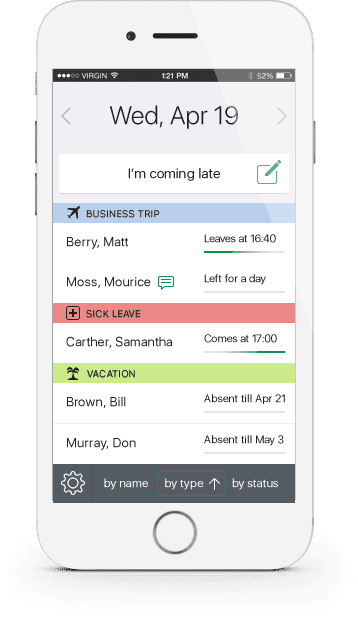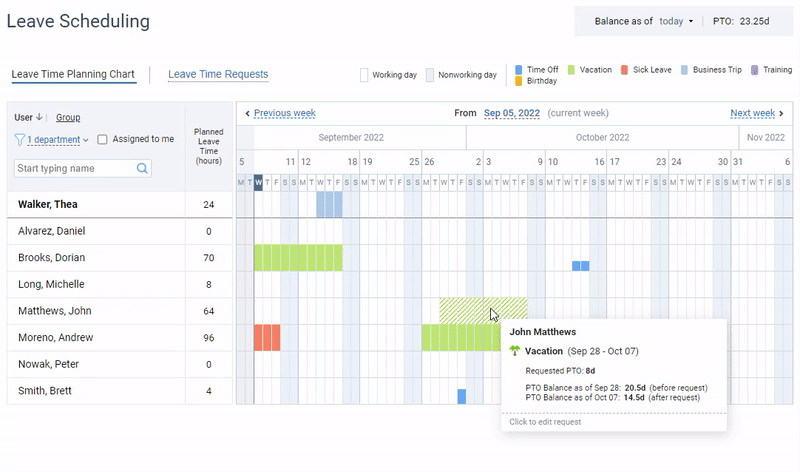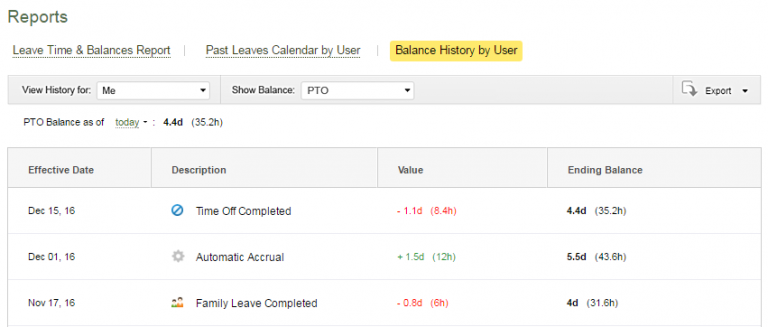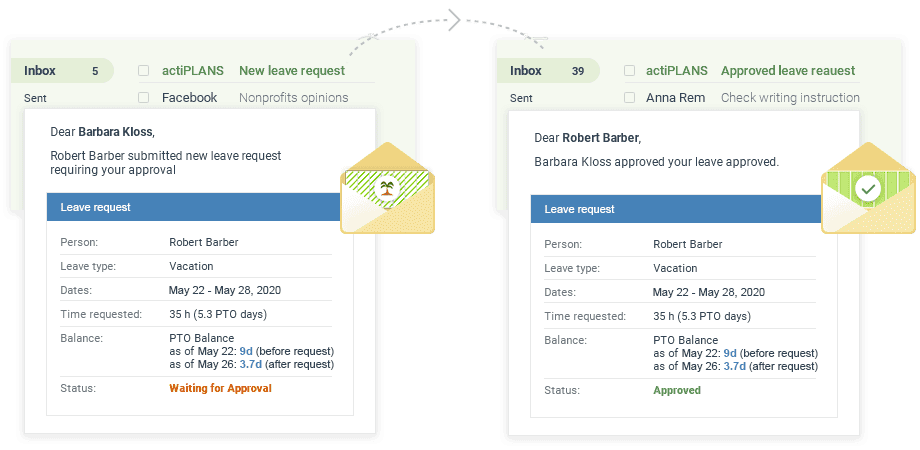Effective leave management is a must-have in every organization. It helps to maintain a proper work-life balance among employees, plan out workforce capacity, and allocate resources efficiently.
In other words, it’s a major prerequisite for high business productivity and employee satisfaction.
And while many companies still use traditional holiday request forms to process leave time, they can hardly be called effective management tools. In this post, we explore all their shortfalls in-depth and explain why you should opt for an automated leave management solution.
What Is a Holiday Request Form?
A holiday request form is a formal document used by employees to request time off from work for holidays, vacations, or personal leave. This form helps employers manage and approve leave requests in an organized manner, ensuring that business operations continue smoothly without disruptions due to overlapping or excessive staff absences.
Key Components of a Holiday Request Form
Employee Information:
- Name
- Department
- Employee ID (if applicable)
Details of the Leave:
- Start date of the leave
- End date of the leave
- Total number of days requested
Reason for the Leave:
- Specific holiday (if applicable)
- Vacation, personal reasons, etc.
Manager/Supervisor Approval:
- Signature of the manager or supervisor
- Date of approval or denial
- Any comments or conditions related to the approval
Employee Acknowledgment:
- Employee signature
- Date of submission
Additional Details:
- Contact information during the leave period
- Details about task handover or work coverage during the absence
Main Purposes of Holiday Request Forms
- Record Keeping: It creates a documented record of leave requests and approvals.
- Planning and Coordination: Helps managers plan staffing levels and manage workloads effectively during the holiday period.
- Compliance: Ensures that leave policies are followed and that employees receive the leave they’re entitled to.
Main Shortfalls of Holiday Request Forms
Limited access to PTO accrual data
When employees use a manual or paper-based holiday request form, they often lack real-time information about their current PTO balance.
This lack of access can lead to several issues:
- Inaccurate Requests: Employees might request more days off than they have accrued, leading to complications or the need for adjustments later on. Without knowing their exact PTO balance, they might underestimate or overestimate their available leave.
- Administrative Delays: HR or management may need to manually check the employee’s PTO balance before approving the request, leading to delays in the approval process. This inefficiency can be frustrating for both the employee and the employer, especially in situations where quick decisions are needed.
- Reduced Employee Autonomy: Employees are less empowered to manage their time off effectively when they don’t have easy access to their PTO data. This can result in either underutilization or overutilization of leave, impacting both the employee’s well-being and the organization’s staffing needs.
Lengthy and inconvenient process
Traditional paper-based holiday request forms often require multiple manual steps and thus are cumbersome and time-consuming for both employees and managers.
Here’s why:
- Manual Submission: Employees often need to fill out a physical form or a basic digital document, which they then must submit to their manager or HR department. This process can involve printing the form, filling it out by hand, and delivering it in person or via email. The manual nature of these steps makes the process slow and prone to delays.
- Approval Bottlenecks: Once submitted, the request typically needs to be reviewed and approved by a manager, and possibly by HR. If the manager is unavailable or busy, the approval can be delayed, leaving employees uncertain about their plans. Additionally, if multiple levels of approval are required, each stage adds to the waiting time.
- Lack of Transparency: Employees may not have visibility into the status of their requests. They might need to follow up manually to check if their leave has been approved or if further information is needed, adding to the inconvenience.
- Inflexibility: Traditional forms are often rigid, with little room for adjustments once submitted. If an employee needs to amend their request or change dates, they might need to start the process again, adding to the inconvenience.
Impact:
This lengthy and inconvenient process can lead to frustration, decreased productivity, and even morale issues as employees feel their time off is not easily accessible or efficiently managed.
It can also burden HR departments with unnecessary administrative tasks, diverting attention from more strategic functions.
Risk of human errors
The process of filling out, submitting, and processing holiday request forms is susceptible to mistakes. These errors can occur at various stages:
- Filling Out the Form: Employees may inadvertently enter incorrect information, such as wrong dates, misspellings, or omitting required fields. These errors can result in misunderstandings about when the employee intends to take leave, leading to potential scheduling conflicts or unauthorized absences.
- Manual Data Entry: If the holiday request form is processed manually, HR staff or managers must often transfer the information into a central system, such as a spreadsheet or leave management system. During this transfer, errors like typos, transposing numbers, or missing data can occur. These inaccuracies can affect the accuracy of leave balances, payroll calculations, and staffing plans.
- Approval Process: Managers may overlook important details on the form or misinterpret the information provided, leading to incorrect approvals or denials. Additionally, if forms are misplaced or lost, the request might never be processed, causing frustration for the employee.
- Record Keeping: Maintaining physical forms or even basic digital records increases the risk of misfiling, accidental deletion, or loss of important documents. This can make it difficult to track past leave requests, leading to potential disputes over leave entitlements or accruals.
- Communication Errors: Miscommunication between employees, managers, and HR departments can arise from unclear handwriting, ambiguous wording, or incomplete forms. These communication gaps can result in misunderstandings about the leave dates or the status of the request.
Impact:
Human errors in the holiday request process can lead to several negative outcomes, such as:
- Disruptions in Business Operations: Incorrectly recorded leave can lead to unplanned absences, leaving teams short-staffed and potentially disrupting workflow.
- Employee Dissatisfaction: Errors in leave requests can cause frustration and dissatisfaction among employees, especially if their time off isn’t accurately recorded or approved.
- Inaccurate Leave Balances: Mistakes in tracking leave can lead to incorrect PTO balances, which results in overpaid or underpaid time off, complicating payroll processing and creating financial discrepancies.

Challenges with historical data analysis
When holiday requests are managed through traditional forms – whether paper-based or simple digital documents – it becomes difficult to track, access, and analyze historical data over time. These challenges manifest in several ways:
- Fragmented Records: Traditional holiday request forms are often stored in various locations, such as physical filing cabinets, spreadsheets, or different email threads. This fragmentation makes it hard to compile and access comprehensive data on employee leave history, especially when retrieving records for a specific employee or period.
- Time-Consuming Data Retrieval: If historical data is needed for analysis – such as understanding trends in employee absences, peak leave periods, or department-specific leave patterns – retrieving this information from scattered or poorly organized records can be very time-consuming. Manual searches through physical files or multiple digital records can lead to delays and incomplete data gathering.
- Inconsistent Record Keeping: Over time, inconsistencies in how leave is recorded (e.g., differences in format, missing data, or errors in entry) can make historical data unreliable. This inconsistency hampers accurate analysis and can lead to flawed conclusions or decisions based on incomplete information.
- Limited Analytical Tools: Traditional holiday request forms do not easily lend themselves to advanced data analysis. Without integration into a centralized system, it’s difficult to perform complex analyses, such as identifying long-term trends in absenteeism, understanding the impact of leave on productivity, or forecasting future staffing needs based on historical patterns.
- Inability to Generate Reports: Organizations often need to generate reports on employee leave for management, compliance, or audit purposes. Traditional forms make it difficult to generate these reports quickly or accurately, as the data needs to be manually compiled and analyzed, increasing the risk of errors and omissions.
Impact:
- Poor Workforce Planning: Without accurate historical data, organizations struggle to predict leave trends and plan staffing levels effectively, which leads to understaffing or overstaffing during critical periods.
- Compliance Risks: In some industries, organizations are required to maintain accurate records of employee leave for legal or regulatory purposes. Difficulties in accessing and analyzing historical data can result in non-compliance or challenges during audits.
- Limited Insight for Decision-Making: Management may lack the necessary insights to make informed decisions regarding leave policies, employee satisfaction, or productivity, as they don’t have a clear picture of past leave patterns.
Security risks
Holiday request forms often contain personal and sensitive information, such as employee names, contact details, dates of absence, and possibly reasons for leave. When these forms are managed through traditional methods, they are vulnerable to various security risks:
- Physical Document Vulnerability:
- Loss or Theft: Paper-based forms can be easily lost, misplaced, or stolen. If these documents fall into the wrong hands, sensitive employee information could be exposed, leading to privacy breaches.
- Unauthorized Access: Physical forms are often stored in filing cabinets or desks that may not be adequately secured. Unauthorized personnel could access these documents, leading to potential misuse of information.
- Digital File Risks:
- Insecure Storage: If holiday request forms are stored as digital files (e.g., spreadsheets, PDFs) on local drives or shared network folders without proper encryption or access controls, they are at risk of being accessed by unauthorized users. This lack of security can result in data breaches, especially if the files are shared through unsecured channels like email.
- Data Corruption or Loss: Digital files can be accidentally deleted, corrupted, or compromised by malware, leading to the loss of important employee records. Without backups or secure storage solutions, recovering this data may be impossible.
- Lack of Audit Trails:
- Inability to Track Access: Traditional holiday request forms often lack audit trails that record who has accessed, modified, or approved the forms. This makes it difficult to monitor and control access to sensitive information, increasing the risk of unauthorized changes or data leaks.
- Difficulty in Detecting Breaches: Without proper tracking and security measures, it may be difficult to detect if sensitive information has been compromised. This delay in identifying breaches can lead to prolonged exposure of private data.
- Inadequate Compliance with Data Protection Laws:
- Regulatory Violations: Many countries have strict data protection regulations, such as GDPR in Europe, which require organizations to safeguard personal information. Traditional forms that are not adequately protected may fail to comply with these regulations, leading to legal consequences, fines, and damage to the organization’s reputation.
How to Request Holidays in a More Efficient Way?
The answer is simple – use automated leave management software like actiPLANS!

actiPLANS is a comprehensive leave management system designed to streamline and improve the process of managing employee time off. It effectively addresses the common shortfalls associated with traditional holiday request forms.
Here’s how:
- Automated PTO Tracking: actiPLANS automatically calculates and tracks PTO accruals based on the organization’s policies. Employees can easily see how much leave they have accrued, how much they have used, and how much remains, all in real-time. This eliminates the guesswork and manual calculations that can lead to mistakes with traditional forms.
- Transparency and Accessibility: Both employees and managers have instant access to accurate leave balances and other relevant data directly within the system. This easy access ensures that employees can make informed decisions about their leave requests, and managers can approve requests confidently, knowing the current status of PTO balances.

- Streamlined Request Process: Employees can submit leave requests with just a few clicks through actiPLANS. The system is designed to be user-friendly, reducing the complexity and time involved in submitting a request compared to traditional paper forms.
- Automated Notifications: Once a leave request is submitted, the system automatically sends notifications to the relevant managers for approval. Managers can then approve or deny the request with a single click. The employee is notified immediately of the decision, streamlining communication and reducing delays.
- Real-Time Updates: actiPLANS ensures that all stakeholders are kept in the loop with real-time updates on the status of leave requests, which helps avoid confusion and ensures that everyone is on the same page.

- Elimination of Manual Data Entry: actiPLANS automates many of the tasks that would typically be done manually, such as calculating leave balances, entering data into records, and sending notifications. This automation significantly reduces the likelihood of errors that can occur when these tasks are done by hand.
- Consistent Data Handling: By centralizing leave management in a single platform, actiPLANS ensures that data is consistently recorded and processed, minimizing discrepancies and errors that can arise from fragmented or inconsistent record-keeping.
- Centralized Data Repository: actiPLANS stores all leave records in a centralized digital database, making it easy to access and analyze historical data. This allows HR teams and managers to track leave patterns, identify trends, and generate reports with ease.
- Advanced Reporting and Analytics: The system provides tools for generating detailed reports on leave usage, work time, and other relevant metrics. This historical data can be used for workforce planning, compliance, and making informed decisions about leave policies.

On top of that, actiPLANS offers robust security features: encryption, access controls, and audit trails to protect sensitive information.
It also ensures compliance with data protection regulations and provides a more reliable and secure way to manage and store employee leave records than any traditional holiday request form.
Give it a try!




